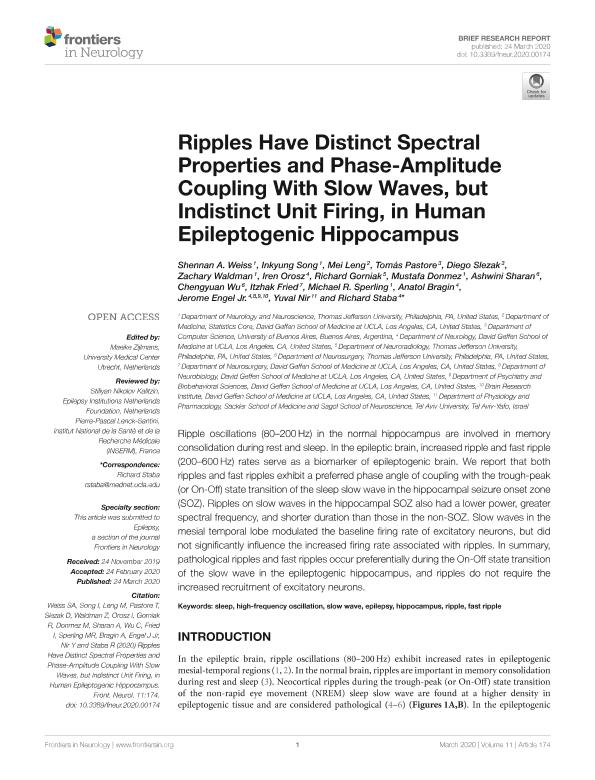Artículo
Ripples Have Distinct Spectral Properties and Phase-Amplitude Coupling With Slow Waves, but Indistinct Unit Firing, in Human Epileptogenic Hippocampus
Weiss, Shennan A.; Song, Inkyung; Leng, Mei; Pastore, Tomás; Fernandez Slezak, Diego ; Waldman, Zachary; Orosz, Iren; Gorniak, Richard; Donmez, Mustafa; Sharan, Ashwini; Wu, Chengyuan; Fried, Itzhak; Sperling, Michael R.; Bragin, Anatol; Engel, Jerome; Nir, Yuval; Staba, Richard
; Waldman, Zachary; Orosz, Iren; Gorniak, Richard; Donmez, Mustafa; Sharan, Ashwini; Wu, Chengyuan; Fried, Itzhak; Sperling, Michael R.; Bragin, Anatol; Engel, Jerome; Nir, Yuval; Staba, Richard
 ; Waldman, Zachary; Orosz, Iren; Gorniak, Richard; Donmez, Mustafa; Sharan, Ashwini; Wu, Chengyuan; Fried, Itzhak; Sperling, Michael R.; Bragin, Anatol; Engel, Jerome; Nir, Yuval; Staba, Richard
; Waldman, Zachary; Orosz, Iren; Gorniak, Richard; Donmez, Mustafa; Sharan, Ashwini; Wu, Chengyuan; Fried, Itzhak; Sperling, Michael R.; Bragin, Anatol; Engel, Jerome; Nir, Yuval; Staba, Richard
Fecha de publicación:
03/2020
Editorial:
Frontiers Media
Revista:
Frontiers in Neurology
e-ISSN:
1664-2295
Idioma:
Inglés
Tipo de recurso:
Artículo publicado
Clasificación temática:
Resumen
Ripple oscillations (80–200 Hz) in the normal hippocampus are involved in memory consolidation during rest and sleep. In the epileptic brain, increased ripple and fast ripple (200–600 Hz) rates serve as a biomarker of epileptogenic brain. We report that both ripples and fast ripples exhibit a preferred phase angle of coupling with the trough-peak (or On-Off) state transition of the sleep slow wave in the hippocampal seizure onset zone (SOZ). Ripples on slow waves in the hippocampal SOZ also had a lower power, greater spectral frequency, and shorter duration than those in the non-SOZ. Slow waves in the mesial temporal lobe modulated the baseline firing rate of excitatory neurons, but did not significantly influence the increased firing rate associated with ripples. In summary, pathological ripples and fast ripples occur preferentially during the On-Off state transition of the slow wave in the epileptogenic hippocampus, and ripples do not require the increased recruitment of excitatory neurons.
Palabras clave:
EPILEPSY
,
FAST RIPPLE
,
HIGH-FREQUENCY OSCILLATION
,
HIPPOCAMPUS
,
RIPPLE
,
SLEEP
,
SLOW WAVE
Archivos asociados
Licencia
Identificadores
Colecciones
Articulos(ICC)
Articulos de INSTITUTO DE INVESTIGACION EN CIENCIAS DE LA COMPUTACION
Articulos de INSTITUTO DE INVESTIGACION EN CIENCIAS DE LA COMPUTACION
Citación
Weiss, Shennan A.; Song, Inkyung; Leng, Mei; Pastore, Tomás; Fernandez Slezak, Diego; et al.; Ripples Have Distinct Spectral Properties and Phase-Amplitude Coupling With Slow Waves, but Indistinct Unit Firing, in Human Epileptogenic Hippocampus; Frontiers Media; Frontiers in Neurology; 11; 3-2020
Compartir
Altmétricas



